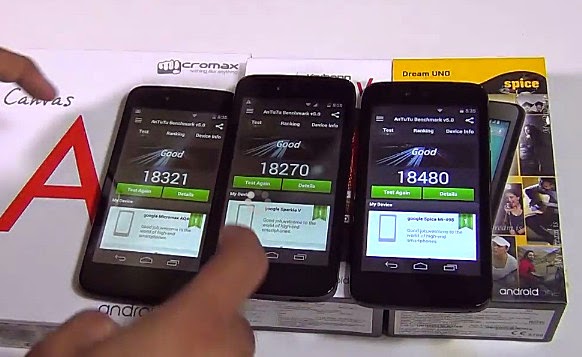What is Android One and Why It Matters to Young Consumers
"Sir Mark, I've been reading a lot of articles about Android One phones the past few days -- and I'm wondering, how are these devices different from the many affordable Android handsets that are already available in the Philippines?" That's the question that I got last night from Jay Concepcion, one of my young readers from Makati City. And I think it's a good one.
If you've been following Google and the growth of its mobile platform, I bet that same question has already crossed your mind. After all, with the way the company describes Android One, it's not hard to imagine many of the phones that are now out in the market - especially those from our local players - to be in that new "product category."
If you're hearing about it for the first time, Android One phones are built by leading hardware manufacturers - including HTC, Alcatel, Asus, Lenovo, among others - working in collaboration with Google. These devices are designed to be both capable and affordable so as to fully democratize the use of smartphones in emerging markets across the world.
According to Google, "The world is filled with potential. People who are ready to leave their mark, and have fun doing it. People eager to create, listen, learn, explore, collaborate, speak, and dance. Right now, only 1 in 4 people own a smartphone. Imagine what's possible if everyone has a phone as ambitious as they are." That's the vision behind Android One.

Going back to Jay's question, I'd say there are three factors that set Android One devices apart from other affordable handsets out in the market. First, they have to be crafted in close partnership with Google. Second, because of that close collaboration, Android One phones are always the first to get official Android firmware upgrades just like Google's Nexus releases. Finally, they have to meet standards set by Google in terms of technical specifications for specific periods. Currently, Android One releases are expected to run on a Quad Core processor by MediaTek and to have front and back cameras, Dual SIM capability, a microSD card for storage expansion, and a battery that's big enough to provide a whole day of uptime.
Google's partner OEMs will have meet those requirements all while making sure that the retail price of their Android One phones won't exceed $120 or Php 5,300 with current conversion. Donning such an affordable SRP, these devices will definitely be very attractive to budget-conscious consumers especially students and yuppies -- as the product would allow them to experience the benefits of an Android smartphone in its full blossom without having to break the bank.
That said, let me share with you one of our TechPinas Writer Fellows' thoughts about Android One; Nico Aguila is a college student taking up Industrial Engineering at De La Salle University - Main Campus in Metro Manila.
Android One From A Student's Point of View
Last September 15, Google announced Android One, a program where Google itself - in partnership with OEMs around the world - will be the main player of designing cost-conscious hardware so that the companies of the developing world will simply manufacture it.
Redesigning a handset to further reduce cost takes up time and resources, and Google wants to somehow take that burden off the shoulders of the companies that sell handsets for price-conscious users. In turn, all the handsets that come from the Android One program will get the same software advantage that Nexus and Google Play users have in terms of software updates.

Android One can deliver a lot of fringe benefits as well. Some of which may be
With an Android phone that has decent specs and having the reassurance that the device will always get the freshest Firmware updates from Google on time, I know that I rely on Android One in accomplishing my daily tasks as a student and as a young techie. Who knows? Maybe the phone can even help me discover other passions -- like being a full-blown developer for Android.
I believe there are a lot of opportunities for Android One to make waves in the Philippines. I’m excited to see one as well. Imagine purchasing a handset that you can call your very own “Nexus” device, which you bought at half the price. That would be a sweet deal.
If you've been following Google and the growth of its mobile platform, I bet that same question has already crossed your mind. After all, with the way the company describes Android One, it's not hard to imagine many of the phones that are now out in the market - especially those from our local players - to be in that new "product category."
If you're hearing about it for the first time, Android One phones are built by leading hardware manufacturers - including HTC, Alcatel, Asus, Lenovo, among others - working in collaboration with Google. These devices are designed to be both capable and affordable so as to fully democratize the use of smartphones in emerging markets across the world.
According to Google, "The world is filled with potential. People who are ready to leave their mark, and have fun doing it. People eager to create, listen, learn, explore, collaborate, speak, and dance. Right now, only 1 in 4 people own a smartphone. Imagine what's possible if everyone has a phone as ambitious as they are." That's the vision behind Android One.

Going back to Jay's question, I'd say there are three factors that set Android One devices apart from other affordable handsets out in the market. First, they have to be crafted in close partnership with Google. Second, because of that close collaboration, Android One phones are always the first to get official Android firmware upgrades just like Google's Nexus releases. Finally, they have to meet standards set by Google in terms of technical specifications for specific periods. Currently, Android One releases are expected to run on a Quad Core processor by MediaTek and to have front and back cameras, Dual SIM capability, a microSD card for storage expansion, and a battery that's big enough to provide a whole day of uptime.
Google's partner OEMs will have meet those requirements all while making sure that the retail price of their Android One phones won't exceed $120 or Php 5,300 with current conversion. Donning such an affordable SRP, these devices will definitely be very attractive to budget-conscious consumers especially students and yuppies -- as the product would allow them to experience the benefits of an Android smartphone in its full blossom without having to break the bank.
That said, let me share with you one of our TechPinas Writer Fellows' thoughts about Android One; Nico Aguila is a college student taking up Industrial Engineering at De La Salle University - Main Campus in Metro Manila.
Android One From A Student's Point of View
Last September 15, Google announced Android One, a program where Google itself - in partnership with OEMs around the world - will be the main player of designing cost-conscious hardware so that the companies of the developing world will simply manufacture it.
Redesigning a handset to further reduce cost takes up time and resources, and Google wants to somehow take that burden off the shoulders of the companies that sell handsets for price-conscious users. In turn, all the handsets that come from the Android One program will get the same software advantage that Nexus and Google Play users have in terms of software updates.

Android One can deliver a lot of fringe benefits as well. Some of which may be
- The push that these budget-focused companies need in order to create a richer user experience now that there will be a standardized blueprint for the handsets
- Aspiring developers like me can purchase a handset for testing out their latest creations, assuming that the devices coming from the Android One program are also easy to tinker with, just like the Nexus devices
- Electronics giants will be pressured as well to update their devices as quickly as possible, or lose their low-end market to those under the Android One program
With an Android phone that has decent specs and having the reassurance that the device will always get the freshest Firmware updates from Google on time, I know that I rely on Android One in accomplishing my daily tasks as a student and as a young techie. Who knows? Maybe the phone can even help me discover other passions -- like being a full-blown developer for Android.
I believe there are a lot of opportunities for Android One to make waves in the Philippines. I’m excited to see one as well. Imagine purchasing a handset that you can call your very own “Nexus” device, which you bought at half the price. That would be a sweet deal.
 | #TPWriterFellows Batch 1 Member and DLSU student, Nico Aguila is the self-proclaimed 'official' tech support guy of his friends. He's always ready to give you tips and tricks with Android devices and even gives you advice on which phone or tablet you should get whether it be running on Android, iOS, or Windows Phone operating system. Nico sees TechPinas as the best tech website in the Philippines and also as his safe haven when he reads tech news that is happening in the country. When he graduates, Nico plans to find a stable job in tech, have a family when he can, and of course, expose his future kids to technology and TechPinas so that they'll enjoy great bonding times together. |
Labels:
Android One
Cellphone
Featured
Google
Smartphones
TechPinas Founder Notes
TechPinas Writer Fellow



.jpg)